Contact Details: Scotch Macaskill, Dirt Road Traders, Currys Post Road, Howick, KwaZulu-Natal, South Africa. Tel: +27 (0)82 578 2329. Privacy: Your privacy is guaranteed. See our Privacy Policy for more. This site accepts advertising and other forms of compensation - see Disclosure and Advertising for details. Site updated: 2022. Copyright © 2002 - 2022 Scotch Macaskill

| ||||||||||
|
||||||||||
|
SEE ALL
|
Africa's Dangerous Animals ... What If?by Roddy SmithA frequently asked question, especially when we are about to set out on a bush walk in "Big Five" country, is: "What would you do if ......?" My usual answer is "Panic". The guests think I'm joking. It is a reasonable question. The very term Big Five, now so beloved of tourist marketing people, was originally coined by hunters to refer to the five African game species which were quite likely to kill you if you messed up (lion, leopard, African elephant, African buffalo, black rhino). Africa's Big Five .... as you don't want to see them on a bush walk!
Of course there is no definitive answer to the "what if.." question because every situation is different, but there are a few basic principles. Unlike hunters, we bunny-huggers would prefer that human-animal encounters end with all the parties walking away to live happily ever after, so the idea is to make our meetings non-confrontational. It is a bad idea to try to sneak up close to potentially dangerous animals. If they see you at what they consider to be a safe distance they merely keep an eye on you: there is time for both parties to weigh each other up. If they only become aware of you when you are close enough to be an immediate threat they run away, and if you are seen as already being too close to escape from they will attack you in self-defence. This "fight or flight" radius varies according to circumstances, so it is much better to let the animals become aware of you some distance away. Move Slowly in the Bush Always move slowly in the bush and pause often. Not only does this give you time to absorb and be aware of what is around you, but it is reassuring to animals. They themselves only move quickly if they are attacking or running away from something, so fast movements are alarming and threatening. Non-predators will only attack another animal (such as ourselves) in order to protect themselves; predators may do this too but first they weigh us up as potential prey. They are however extremely wary of anything that could injure them; a predator that cannot hunt will die. This means that predators and non-predators look at us from completely different perspectives, and our response must differ accordingly. If we find ourselves confronted by a non-predator we need to appear as unthreatening as possible – look small, be quiet, back off slowly. In contrast a predator needs to be convinced that we are a more formidable proposition – look big, if necessary make noise, once again back off slowly but above all do not run. Africa's Most Dangerous Animal There is one animal, truly Africa's most dangerous, on which none of this works. The crocodile is the most successful terrestrial predator that has ever lived. It too is wary of what it takes on, which is why it has survived for at least 60 million years, but anything it decides is not to be feared, is in trouble. A few years ago there was a tragic incident in Mana Pools in Zimbabwe (across the river from Lower Zambezi National Park) where a young girl was taken from a canoe. No-one could have foreseen this (it is the only instance of this happening in 25 years of canoe trips on the Zambezi) but in hind-sight perhaps the signs were there. Normally at the approach of canoes crocs take refuge in the water when they are still some distance away; this large individual was known for ignoring them, which was probably an indication that he was no longer wary of them. From losing respect it is a short step to attack. The Mana croc was shot, but the lessons were learnt, and so when recently a crocodile in the Lower Zambezi National Park started taking an unwelcome interest in canoes it was decided to take preventive action and having trapped and hunted crocs in the past I got involved. Initially we tried to capture and relocate it to a croc farm using a whip trap, which I have had success with in the past. It consists of a trench dug into the bank with a bait at the end attached to a bent-over sapling (Diospyrus quiloensis is the best). Around the entrance is a noose, also attached to the sapling; if the bait is taken the pole whips up and the noose catches the croc behind the front legs. This was unsuccessful this time and we had to resort to more extreme measures: unfortunate, but better than having another person taken. The croc was eventually shot and proved to be a female measuring about 3.5 metres, rather less than most of us had estimated. At the time it had the detached leg of another crocodile in its mouth and its stomach contained a buffalo hoof, bones and hooves of impala, warthog skin, several stones, and surprisingly to me although I have since found out it is normal, a lot of grass. See also The Nile Crocodile - Stranger than Fiction. Roddy Smith is a wildlife conservationist and safari guide based in the Lower Zambezi National Park, Zambia. Images © Scotch Macaskill Return to Wildlife Articles |
|||||||||
|
|
||||||||||
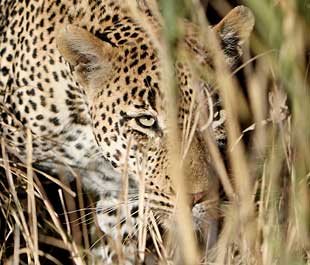 Leopard (Panthera pardus)
Leopard (Panthera pardus)
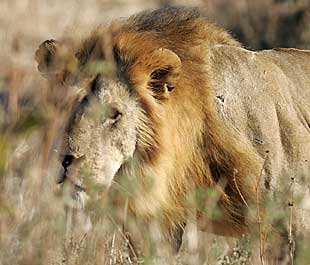 Lion (Panthera leo)
Lion (Panthera leo)
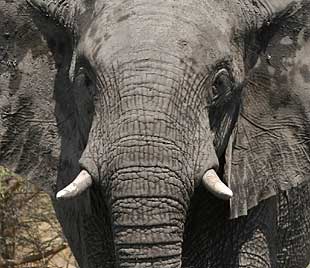 African elephant (Loxodonta africana)
African elephant (Loxodonta africana)
 African buffalo (Syncerus caffer)
African buffalo (Syncerus caffer)
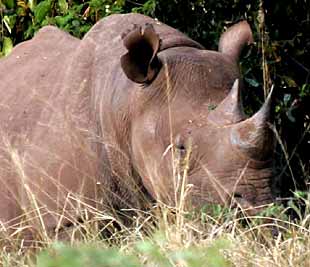 Black or Hook-Lipped rhino (Diceros bicornis)
Black or Hook-Lipped rhino (Diceros bicornis)
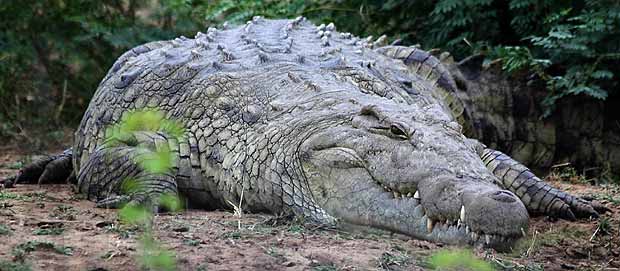 Nile crocodile (Crocodylus niloticus) on the banks of the Zambezi River
Nile crocodile (Crocodylus niloticus) on the banks of the Zambezi River